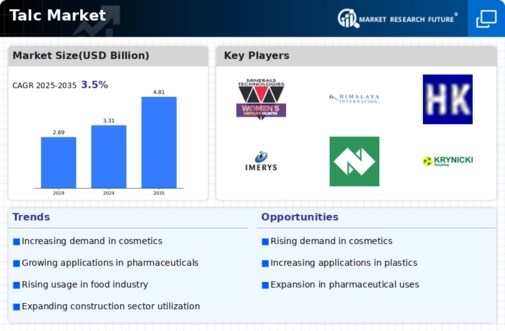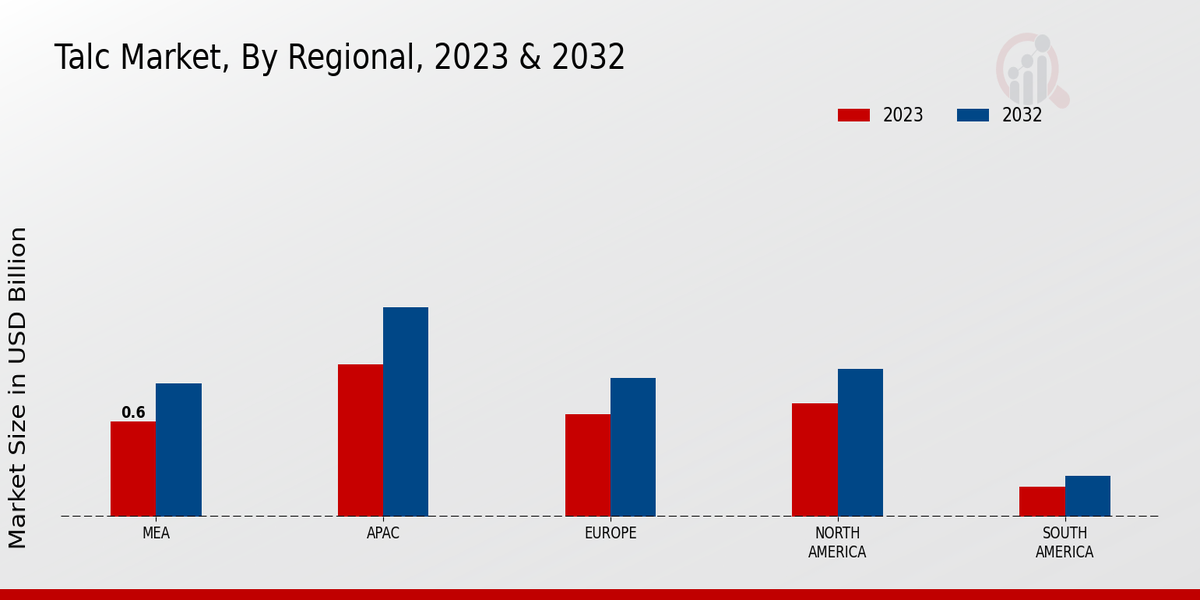Growth in the Plastics Industry
The Global Talc Market Industry is significantly influenced by the expansion of the plastics sector. Talc is employed as a reinforcing filler in various plastic applications, enhancing properties such as stiffness and thermal stability. With the global plastics market projected to grow, the demand for talc is expected to rise correspondingly. This growth is anticipated to propel the market value to 4.81 USD Billion by 2035, reflecting a compound annual growth rate of 3.46% from 2025 to 2035. The increasing use of talc in automotive and packaging applications further underscores its importance in the plastics industry.
Market Trends and Growth Projections
The Global Talc Market Industry is characterized by various trends and growth projections that reflect its evolving landscape. The market is anticipated to reach a valuation of 3.31 USD Billion in 2024, with a steady increase expected to 4.81 USD Billion by 2035. The compound annual growth rate of 3.46% from 2025 to 2035 indicates a stable growth trajectory. Factors such as rising demand in personal care, plastics, and construction sectors are driving this growth. Additionally, advancements in processing technologies and regulatory support are likely to further enhance market dynamics.
Rising Demand in Personal Care Products
The Global Talc Market Industry is experiencing an uptick in demand due to its widespread application in personal care products. Talc is utilized as a filler and anti-caking agent in cosmetics, including powders and lotions. The increasing consumer preference for natural and mineral-based products is driving manufacturers to incorporate talc into their formulations. As a result, the market for talc in personal care is projected to grow, contributing to the overall market valuation of 3.31 USD Billion in 2024. This trend indicates a shift towards cleaner beauty products, which may further enhance the market's growth trajectory.
Advancements in Talc Processing Technologies
Innovations in talc processing technologies are reshaping the Global Talc Market Industry. Enhanced extraction and purification methods are leading to higher quality talc products, which are more appealing to manufacturers across various sectors. These advancements enable the production of talc with improved purity levels, which is crucial for applications in pharmaceuticals and food products. As the demand for high-quality talc rises, the industry is likely to witness increased investments in processing technologies. This trend may contribute to the market's growth, aligning with the projected increase in market value to 4.81 USD Billion by 2035.
Regulatory Support for Mineral-Based Products
The Global Talc Market Industry benefits from regulatory frameworks that promote the use of mineral-based products. Governments are increasingly recognizing the safety and environmental advantages of talc compared to synthetic alternatives. This regulatory support is encouraging manufacturers to adopt talc in various applications, including construction and ceramics. As a result, the market is expected to see sustained growth, with a projected value of 3.31 USD Billion in 2024. The favorable regulatory environment may also enhance consumer confidence in talc-based products, further driving demand across multiple sectors.
Increasing Applications in the Construction Sector
The Global Talc Market Industry is witnessing a surge in demand from the construction sector, where talc is used as a filler in paints, coatings, and sealants. The ongoing global infrastructure development projects are driving the need for high-performance materials, including those containing talc. This trend is expected to bolster the market, with projections indicating a rise to 4.81 USD Billion by 2035. The versatility of talc in improving the durability and aesthetic appeal of construction materials suggests a robust future for its applications in this sector.








